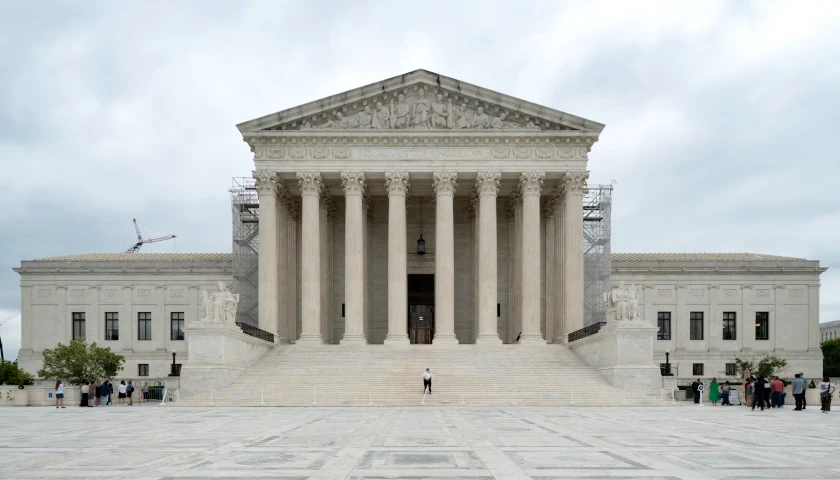Kamala Harris, Joe Biden, media outlets, and so-called “fact checkers” are claiming that “violent crime is near a 50-year low.” In contrast, Donald Trump is alleging that “crime is worse than it’s ever been.”
The reality is that all of them are wrong.
There are three key measures of violent crime with various strengths and weaknesses, but the most reliable and severe one shows that the murder rate in 2023 was 36 percent higher than the modern low in 2014 but 14 percent lower than the modern peak in 2021.
The statistics cited by Harris and others who declare that violent crime is extraordinarily low come from the FBI’s Uniform Crime Report, which is based on voluntary reports of crimes by state and local law enforcement agencies. As explained by the FBI, this report “excludes” crimes like “sexual assault,” “simple assault,” “attempted robberies,” and “crimes not reported to law enforcement.”
Regarding the last of those exclusions, the FBI discloses that “changes in police procedures, shifting attitudes toward crime and police, and other societal changes can affect the extent to which people report and law enforcement agencies record crime.” Thus, the FBI cautions against “making any direct comparison between data in this publication and those in prior” years.
If one ignores that warning — and all of the crimes not recorded in the Uniform Crime Report — violent crime appears to be near a 50-year low:
![]()
Trump claims that “the FBI defrauded everybody because what they did is they used statistics not including some of the worst areas and some of the worst cities.” This simply isn’t true, even in light of the fact that the FBI stealthily revised its 2022 crime data, which is accounted for in the chart above.
Contrary to Trump, the FBI provides “statistics for the entire United States” by including “estimated” crime numbers for law enforcement agencies that don’t report data to the FBI. This creates uncertainty, but agencies who submitted data to the FBI in 2023 covered 94.3 percent of the U.S. population and “every city agency” covering a million or more people.
On the other hand, the FBI has been burying crime data since the outset of the Biden administration, and this has led to some massive underreports of violent crime. For a prime example, NewsNation reported in 2022 that 14,677 murders occurred in 2021 based on the FBI’s convoluted presentation of its data. This was 8,000 fewer murders than the FBI’s actual estimate of 22,900 murders that year.
To rectify this problem, Just Facts has posted the FBI’s Uniform Crime Reports for 2020/2021, 2022, and 2023 at easily accessible permalinks. The FBI has buried these datasets in a fragmented manner under a maze of vaguely worded dropdown menus and acronyms with expiring hyperlinks.
Reports for earlier years are still readily available from the FBI.
DOJ Data
Another common source of violent crime data is the National Crime Victimization Survey (NCVS), which is conducted by the Department of Justice. In the words of an academic book published by the National Academies of Sciences, Engineering, and Medicine, this survey “is widely viewed as a ‘gold standard for measuring crime victimization’.”
Nevertheless, the book warns that the NCVS is “beset with methodological problems of surveys in general as well as particular problems associated with measuring illicit, deviant, and deleterious activities….”
The survey is based on a statistically powerful nationally representative sample of 160,000 people, but it doesn’t measure “homicide, arson, commercial crimes, and crimes against children under age 12.”
Also, it includes simple assaults in its violent crime rates, which commonly involve no injuries or minor ones.
Like the FBI data, the NCVS shows large declines in violent crime since the early 1990s, but it greatly differs from the FBI data in recent years and shows an apparent 37 percent increase in violent crime from 2020 to 2023:
![]()
Given sampling margins of error, the NCVS violent crime rate may have risen by as little as 12 percent to as much as 69 percent from 2020 to 2023. Regardless, this is a sizeable disconnect from FBI statistics, which show a 6 percent decrease in the violent crime rate from 2020 to 2023.
Murder Data
The only measure of violent crime that transcends the vagaries of FBI and NCVS data is murder. Although counts of murders exclude all lower-level crimes, they capture the harshest and best-measured one.
Per a 2010 DOJ report, “Homicide is of interest not only because of its severity but also because it is a fairly reliable barometer of all violent crime. At a national level, no other crime is measured as accurately and precisely.”
There are two primary measures of murder — the FBI’s Uniform Crime Report and death certificate data compiled by the CDC. As explained in a 2014 DOJ report, death certificates provide “more accurate homicide trends at the national level than” FBI data because:
- the reporting of death certificates is “mandatory,” while the FBI relies on “voluntary” reports “from individual law enforcement agencies that are compiled monthly by state-level agencies.”
- death certificates include homicides that “occur in federal jurisdictions,” while the FBI rarely counts “homicides occurring in federal prisons, on military bases, and on Indian reservations.”
- death certificates include homicides caused by the deliberate “crashing of a motor vehicle, but this category generally accounts for less than 100 deaths per year.”
However, death certificates tend to overcount murders because they include:
- justifiable homicides by civilians acting in self-defense, which are not murders.
- some justifiable homicides by police, even though these are supposed to be coded as “legal intervention deaths,” not as homicides.
The 2014 DOJ report suggests that “a more comprehensive understanding of homicide in the United States can perhaps be achieved by combining the strengths of the two data collection systems.” Hence, Just Facts developed a methodology to combine data from both sources and a scholarly journal to produce murder estimates. This yields figures that are higher than the FBI’s estimates and 4.2 percent lower than the number of homicides recorded on death certificates.
Contrary to Harris, the media, and to Trump, these data show that the murder rate in 2023 was 36 percent higher than the modern low in 2014 but 14 percent lower than the modern peak in 2021:
While ignoring the fact that correlation does not prove causation, many media outlets and Democrats have blamed the surge in murders in 2020 on Covid-19 and Trump. In reality, the facts point to the BLM movement as the most likely cause. The same applies to the murder surge in 2015.
– – –
James D. Agresti is the president of Just Facts, a think tank dedicated to publishing rigorously documented facts about public policy issues. He holds a Bachelor of Science in Mechanical Engineering from Brown University and has worked as a designer of jet engine components and systems, a technical sales professional, and chief engineer of a firm that customizes helicopters. He is also the author of Rational Conclusions, a meticulously researched and acclaimed book evidencing factual support for the Bible across a broad array of academic disciplines.





